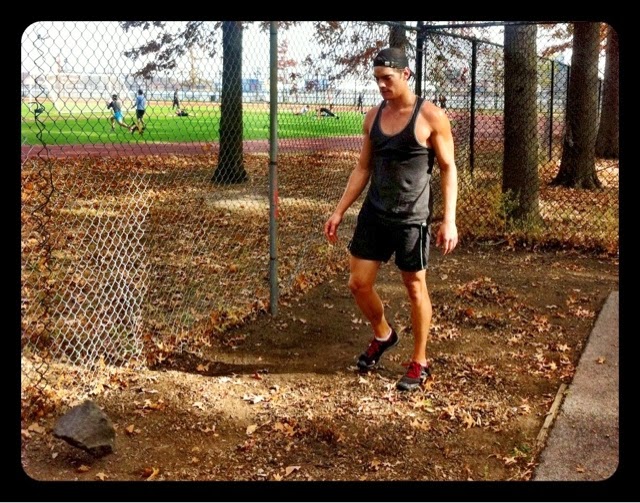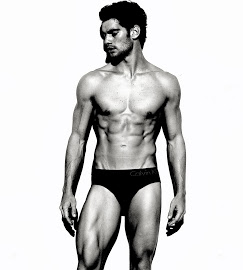Arnie as a teenager (left). Myself as a teenager (right)
While I'll admit that part of my growth potential is genetic, I think it can largely be attributed to my passion/obsession with food, sleep and lifting heavy things. Also in my teenage years I went through a token megalomania phase where I wanted to be Arnold Schwarzenegger. Thankfully I got over that boyish beefcake obsession but it did teach me how to train hard, eat prodigiously and get results fast.
If you're a "hard-gainer" or simply need to build more lean muscle mass here are my five (no shortcut, no supplement, no bullshit) tips to honest muscle growth in a safe, sustainable and healthy way.
1. Eat real (Paleo) food - more than you think you need.
If you are lean, if your current diet sucks, if you're "skinny fat", or if you have been trying to lose weight through calorie restriction (and obviously failing because it doesn't work) the chances are that you are not getting adequate nutrition.
In all of these scenarios, and even if you are overweight, your goal should be to build lean muscle mass, as this is the only sustainable way to improved body composition and optimal health.
You need to be eating enough quality food not only to maintain your current state but to build new tissue. That is, you need periods of energy surplus - but only of quality, real (Paleo) foods. Extra calories from crabby carbs like sweetened cereals, protein bars, shakes and juice will screw your metabolism and counter your efforts to grow lean.
So cut the processed, adulterated, modern food out of your diet and eat big, satiating meals of whole foods that are high in quality fats, moderate in protein (you don't need to consume prodigious amounts of protein to gain muscle), and moderate in safe carbohydrates. I have written many articles on nutrition so check them out for more detail.
But basically you need to focus on nutrient and energy dense foods like pastured eggs, coconut products, oily seafood, sweet potatoes, raw nuts, 85% dark chocolate and (not-too-lean) grass-fed meat and pork.
If you really want to gain size then incorporate more starch such as white rice, sweet potatoes and whole fruit. And if you tolerate dairy then consider adding in fermented, full-fat, (preferably raw) dairy like aged cheese/sour cream/greek yoghurt/kefir.
2. Sleep more
This is both simple and crucial. You cannot repair and rebuild if you don't rest and reset. I believe sleep is actually more important than training.
If you smash the gym but only sleep five hours a night, even if your nutrition is impeccable, you will go backwards and put your health at risk in the long term.
Sleep eight or nine hours a night. The better the quality and quantity of your sleep, the quicker and easier you will gain muscle mass and shed fat.
3. Train hard, smart, and not too much
Lifting heavy weights is not the only way to gain muscle, but it's the best, fastest, and most efficient way.
Exercise needs to be an acute stress to your body - enough that it causes positive adaptation and growth but not so much that it becomes a chronic stress from which you cannot recover.
The effective dose of exercise is actually a lot less than you would think. Given that you train at intensity (that is, complex movements at a challenging amount of weight, until failure, without too much rest) I think that two intense weight sessions per week, such as a circuit of 20-30 minutes if you're not stuffing around, is sufficient to build substantial amounts of muscle without risking injury or overtraining.
I would suggest adding one sprint session to this per week, along with as much low-level movement or activity as possible (e.g. walking, yoga, commuter cycling) and you're good to go!
4. Avoid "chronic cardio"
Q. What do fitness models, sprinters and bodybuilders have in common, besides having massive guns and less than eight percent body fat?
A. They don't do hours of cardio per week.
That's right. If you want to get lean then doing long sessions of steady-state cardio is a very bad way to go about it.
When you're trying to build lean muscle mass a high volume of endurance training or "chronic cardio" will counter your efforts.
Distance running or cycling, for example, is all about efficiency. Do these singular, repetitive movements enough and your body will strip away non-essential muscle to make you more efficient at running or cycling. Just look at pro cyclists or marathoners! Endurance comes at the cost of physique... Unless you're going for that emancipated look (models)?
I'm not saying don't go for a run or ride if you enjoy doing so, I'm just saying that if muscle is your priority then do as little "chronic cardio" as possible and instead focus on high intensity weights and sprints. Feel free to do as much low intensity movement (e.g. walking, yoga, hiking, etc) as you want though.
Arnie after a few more years of steroid abuse...
5. Rest, recover and don't overtrain
I've already mentioned the importance of sleep and the benefits of short, intense workouts over high volume training but I think this point bears repeating.
Smashing yourself at the gym, on the pavement or on the road everyday will be counterproductive to your progress (unless you are 18 years old or devouring anabolics like Arnie in the 70s)
While the precipitous overtraining promoted by hardcore fitness communities [cults] like CrossFit or Barry's Bootcamp does lead to great results initially, I believe that this style of training is both unnecessary and unsustainable for the average person. The risk of injury or burn out is simply not worth the results it if your objective is health and a good physique more so than elite performance.
As a type-A personally who is slightly masochistic I've done my fair share of overtraining in the past. I get it. I loved CrossFit for my brief stint at it. Hard workouts are addictive, especially in a competitive environment or group atmosphere. Yet if your goal is to build muscle in the healthiest, most sustainable way that will enhance longevity rather than hinder it, less is definitely more.
This is why I suggest spacing out your weight sessions with at least one (and up to four) rest days.
My ideal weekly schedule will look something like this:
Monday: heavy lifting session
Tuesday: yoga
Wednesday: sprints
Thursday: weights + metabolic conditioning (i.e. circuit training)
Friday: rest
Saturday: Rest/Play (cycle, surf, walk along the beach/river, get some sun, etc)
Sunday: yoga
In NYC (except for winter) I cycle everywhere on my fixed-gear as my mode of transport... Often up to two hours a day. This does not count as 'training' but rather 'movement’. So even though I am highly active almost every day I only consider myself to be doing around one hour of actual intense 'training' per week, split over three workouts.
Conclusion
If you want to build muscle honestly and healthily you need ample nutrition, sleep and rest. Training is important but intensity trumps volume. To summarize:
- Nutrition: Eat as much clean, real Paleo food as you want/need.
- Sleep: Aim for eight hours a night, minimum.
- Train: Train hard, smart and not too much.
- Avoid chronic cardio: do weights/circuits, sprints and lots of movement.
- Avoid overtraining: rest, recover and rebuild.
"Form a habit. Forge a lifestyle."
The Paleo Model
PS - If you liked this article you can really help me out by sharing it on Facebook or Twitter (with the little buttons below).




































